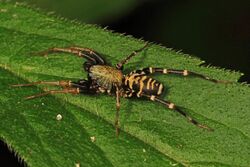Biology:Castianeira
| Castianeira | |
|---|---|

| |
| Castianeira longipalpa in Maryland, United States | |
| Scientific classification | |
| Domain: | Eukaryota |
| Kingdom: | Animalia |
| Phylum: | Arthropoda |
| Subphylum: | Chelicerata |
| Class: | Arachnida |
| Order: | Araneae |
| Infraorder: | Araneomorphae |
| Family: | Corinnidae |
| Genus: | Castianeira Keyserling, 1879[1] |
| Type species | |
| C. rubicunda Keyserling, 1879
| |
| Species | |
|
127, see text | |
| Synonyms[1] | |
Castianeira is a genus of ant-like corinnid sac spiders first described by Eugen von Keyserling in 1879.[5] They are found in Eurasia, Africa, and the Americas, but are absent from Australia . Twenty-six species are native to North America,[6] and at least twice as many are native to Mexico and Central America.[1]
Description
Spiders of this genus have eight eyes in two procurved rows (meaning that the lateral eyes are farther toward the front of the body than the medial eyes), the upper row slightly wider than the lower row. This distinguishes them from species of Micaria that almost always have straight rows of eyes.[6] The opisthosoma is not constricted,[7] and has an elongate to oval shape to mimic that of ants. In addition to the ant-like coloration, the abdomen has white scale-like setae. The rear pair of legs are the longest, and the front pair are second longest.[8]
Mimicry
Some species are ant mimics resembling specific groups of ants, while others only have generic body modifications to look more ant-like, such as an elongated body or a carapace pattern that creates the illusion of a third body segment. Some mimic ant behavior as well, waving their front two legs as if they were antennae or bobbing their abdomen to look more ant-like.[9] Certain species found in Texas mimic fire ants to prey on them, while some species use Batesian mimicry, appearing like velvet ants to take advantage of their aposematism in order to deter predators.[8]
Ant mimicry
Known ant-spider mimicry:
- Castianeira cingulata – short carpenter ants
- Castianeira longipalpa – myrmicine or ponerine ants
- Castianeira memnonia – Pachycondyla obscuricornis Emery
- Castianeira rica – Atta sp, Odontomachus sp, and others
- Castianeira trilineata – reddish carpenter ants (Latreille)
Species
(As of April 2019) it contains 127 species:[1]
References
- ↑ 1.0 1.1 1.2 1.3 Gen. Castianeira Keyserling, 1879. Natural History Museum Bern. 2019. doi:10.24436/2. http://www.wsc.nmbe.ch/genus/525. Retrieved 2019-05-18.
- ↑ 2.0 2.1 2.2 Simon, E (1897). Histoire naturelle des araignées. pp. 167–172. doi:10.5962/bhl.title.51973.
- ↑ Pickard-Cambridge, F. O. (1899), "Arachnida - Araneida and Opiliones", Biologia Centrali-Americana, Zoology, p. 81
- ↑ Keyserling, E. (1887). "Neue Spinnen aus America. VII". Verhandlungen der Kaiserlich-Königlichen Zoologisch-Botanischen Gesellschaft in Wien 37: 376.
- ↑ Keyserling, E. (1879). "Neue Spinnen aus Amerika.". Verhandlungen der Kaiserlich-Königlichen Zoologisch-Botanischen Gesellschaft in Wien 29: 293–349.
- ↑ 6.0 6.1 "Genus Castianeira". BugGuide. https://bugguide.net/node/view/2000. Retrieved 2019-05-18.
- ↑ Ubick, D.; Paquin, P.; Cushing, P.E. et al., eds (2005). Spiders of North America: An Identification Manual. American Arachnological Society. ISBN 0-9771439-0-2.
- ↑ 8.0 8.1 Reiskind, J. (1969). "The spider subfamily Castianeirinae of North and Central America (Araneae, Clubionidae)". Bulletin of the Museum of Comparative Zoology 138: 188–257.
- ↑ "Ant Mimic Spider". Brandeis University. http://www.bio.brandeis.edu/fieldbio/Spiders_Savransky_Suhd_Brondstatter/Pages/Corrinidae_castianeira.html. Retrieved 2019-05-18.
Further reading
- Cushing P.E. (1997). Myrmecomorphy and myrmecophily in spiders: a review. Fla. Entomol. 80:165–193. PDF
Wikidata ☰ Q1311175 entry
 |

